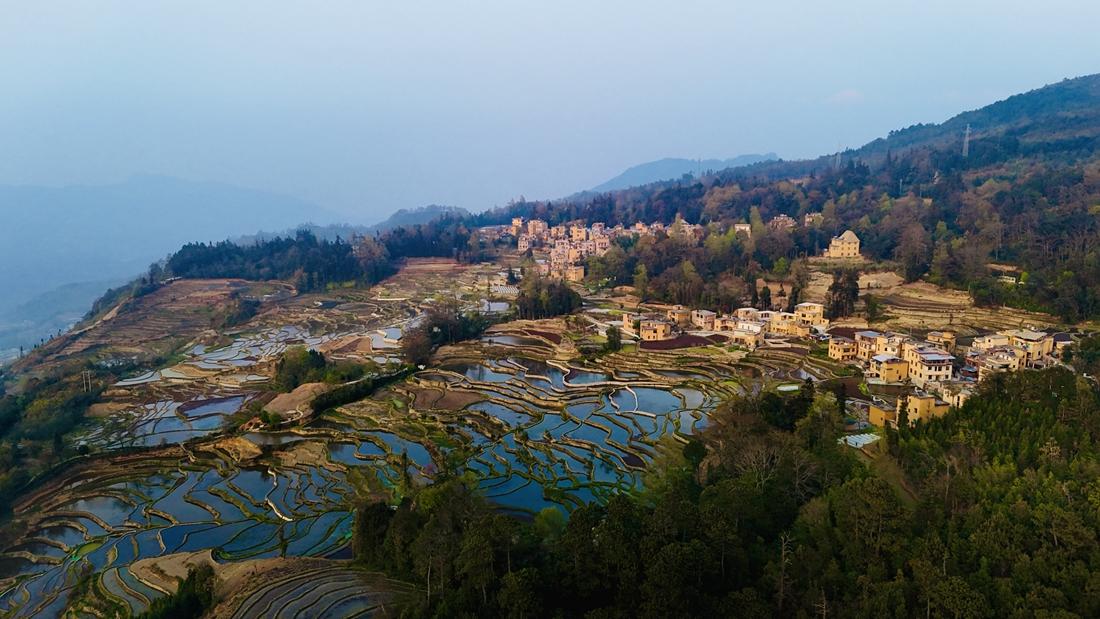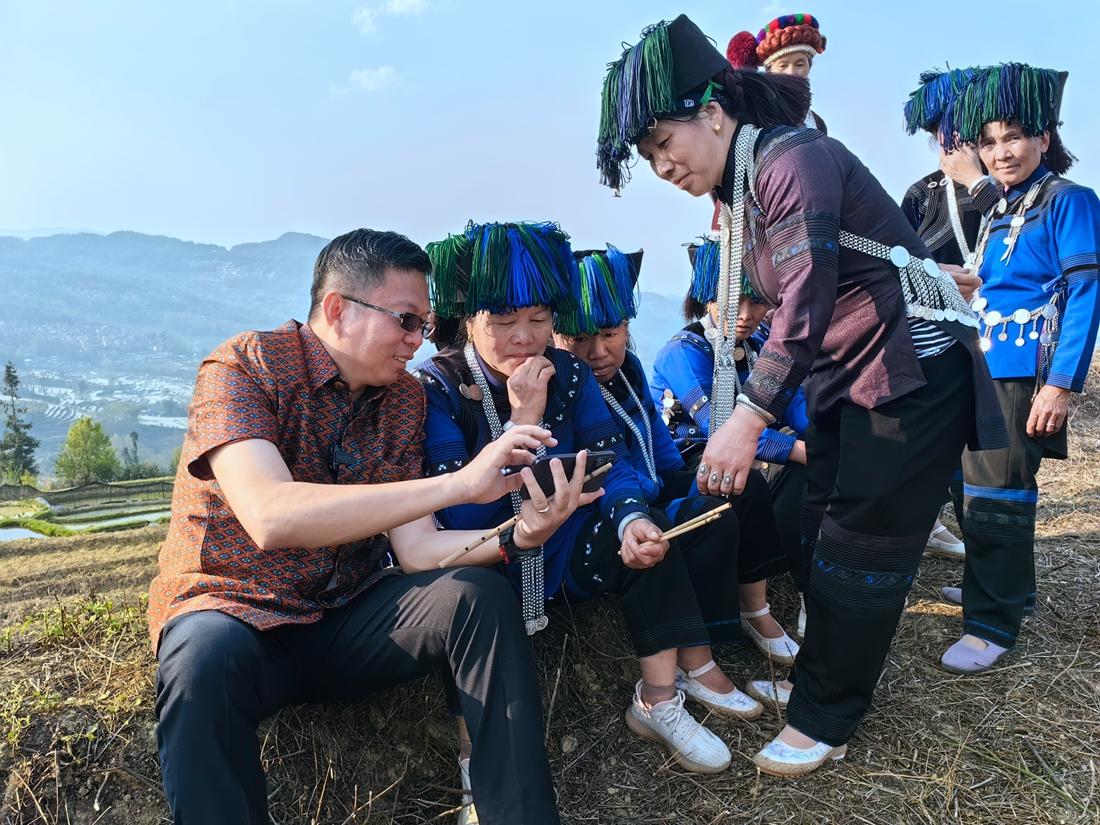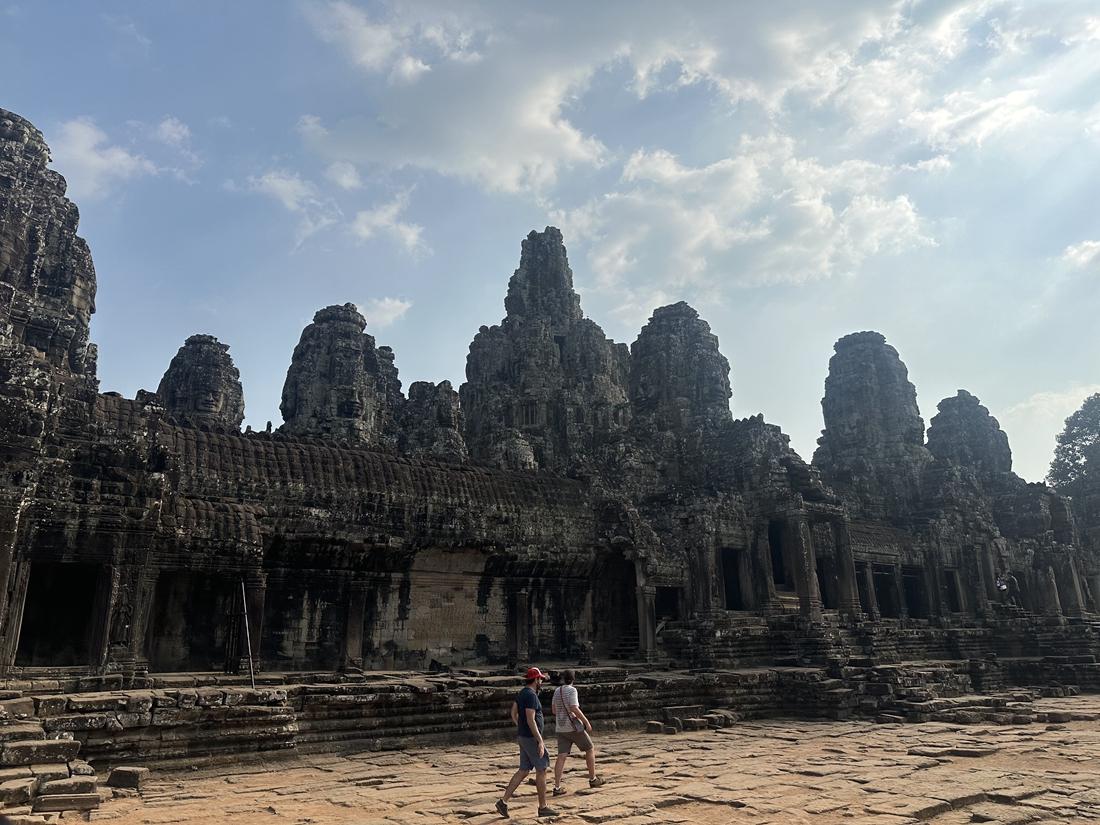Tourism bridges Yunnan and Angkor
In 2024, the “Year of China-Cambodia People-to-People Exchange” takes center stage, underscoring the importance of fostering connections between individuals within the six-pronged “diamond” cooperation framework that exists between China and Cambodia. Yunnan and Angkor, both renowned tourist destinations abundant with World Heritage sites, offer vast opportunities for tourism exchange. Over the course of this year, individuals from Yunnan and Cambodia have engaged in reciprocal visits. By exploring the world heritage sites in each other’s regions, they gain a deeper appreciation for the rich cultural legacy and timeless value these sites hold.

The Hani terraced rice fields in Honghe Hani and Yi Autonomous Prefecture, Yunnan Province
Exploring Yunnan: Reveling in the splendor of Hani Terraced Rice Fields
Dr. Chea Munyrith, a member of the Executive Committee of the Cambodia-China Friendship Association (CCFA) and President of the Cambodian-Chinese Evolution Research Association (CCERA), had a thought-provoking experience during his visit to Azheke Village in Yuanyang County, Honghe Hani and Yi Autonomous Prefecture, Yunnan Province. He discovered many surprises and gained deeper insights into the world cultural heritage, the Honghe Hani Terraced Rice Fields.
On a delightful spring afternoon, as the gentle breeze carried the scent of blossoms, Dr. Chea Munyrith came to Azheke Village, located in Yuanyang County, Honghe Hani and Yi Autonomous Prefecture, Yunnan Province. Adorned in traditional Cambodian attire, he strolled along the meandering path. Azheke Village is a national-level traditional village in China and serves as a pivotal component within the cultural landscape heritage zone of the Hani Terraced Rice Fields, a UNESCO World Cultural Heritage site.
As Dr. Chea walked along the field ridge, he ventured away from the ancient village and stumbled upon a cluster of modern-style houses permeated with the enticing aroma of coffee. While the village initially exuded an air of solitude and charm, it seamlessly harmonized with modern development, unveiling a distinctive vitality.
Dr. Chea stepped into a homestay hotel named “Yuanshe Azheke,” where he was warmly welcomed by a lovely young lady adorned in traditional Hani clothing. “I’m Zhang Ping, but you can call me Xiaohua,” she kindly introduced herself. “Allow me to guide you through our terraced fields, and I’ll also treat you to our Pu-erh tea.” It soon became apparent that Xiaohua was precisely the manager of the homestay hotel.
From the terrace of the homestay hotel, Dr. Chea marveled at the mesmerizing expanse of terraced rice fields, his gaze tracing the intricate contours with admiration. He confessed that he had always regarded this ethereal beauty as something confined to paintings, but now, standing amidst the layers of shimmering terraced rice fields, witnessing the magnificent collaboration between humankind and nature, he was able to truly grasp the awe-inspiring splendor that unfolded before him. As they savored their tea, Xiaohua shared the story of Azheke.

Dr. Chea Munyrith, president of the Cambodian-Chinese Evolution Research Association (CCERA), shares his pictures with locals in Honghe Hani and Yi Autonomous Prefecture, Yunnan Province.
Our village is inhabited by diligent and skilled Hani people. “For generations, we have dedicated ourselves to the cultivation of these remarkable terraced rice fields,” she explained. “Our ancestors, fueled by their profound understanding of nature and their own ingenuity, crafted this breathtaking landscape. The forests nurture the water, the water breathes life into the terraces, and the terraces, in turn, sustain us. With the arrival of tourism, our lives have been enriched both materially and spiritually.” Embracing their traditional way of life, the villagers still rely on time-honored means of transportation, including carrying loads on their backs or utilizing horses for labor-intensive tasks. Even the daily supply runs to the homestay hotel adhere to these customary methods. Their aspiration is to preserve their cherished way of life while simultaneously safeguarding the delicate local ecosystems.
Continuing her narrative, Xiaohua revealed that her homestay hotel had undergone a remarkable transformation, evolving from five traditional Hani dwellings. She clarified that her motive for establishing the homestay was not solely driven by profit, but rather by a desire to showcase the cultural allure of Azheke and safeguard the invaluable ethnic heritage and traditional dwellings through sustainable tourism. With this in mind, meticulous attention was paid to incorporating the ethnic cultural elements of the Hani community and the architectural style of traditional dwellings during the design and construction of the lodging. Their ultimate goal was to create a homestay hotel that would serve as a window on the Hani ethnic culture.
Upon hearing Xiaohua’s account, Dr. Chea was deeply touched by her remarkable dedication. Her passion and unwavering determination to contribute to the betterment of her cherished homeland left a lasting impression on him.
In the reading corner of the homestay hotel, Dr. Chea noticed a book titled “Red Rice Is Ripe.” Intrigued, he delved into its pages and discovered a detailed account of the construction and promotion of the homestay hotel, enriched with the personal reflections and experiences of the villagers involved. Observing Dr. Chea’s interest in the book, Xiaohua graciously presented it to him as a gift, which he gratefully accepted.
The village of Azheke has pleasantly surprised Dr. Chea, sparking deep reflections within him. The villagers’ approach of harnessing the beautiful natural surroundings and the rich humanistic landscape to drive tourism has yielded remarkable results. Not only have they succeeded in preserving the ecological environment and local ethnic culture, but they have also achieved sustainable economic development for the village. Dr. Chea said, “The northern mountainous regions of Cambodia boast breathtaking natural scenery and a diverse array of ethnic cultures. The development model of Azheke Village, focusing on rural revitalization and tourism, serves as an inspiring example worth studying and drawing lessons from.”

The Bayon Temple in Cambodia
Discovering Angkor: Immersing in Cambodia’s rich history and culture
Liu Ziyu, a reporter from the Yunnan Daily Press Group and the Yunnan International Communication Center for South and Southeast Asia, had the opportunity to participate in an interview during the Cambodian New Year. During her time there, she immersed herself in the vibrant local traditional culture and taking part in the lively festive celebrations. Liu also visited several world heritage sites in Cambodia, including the renowned Angkor Wat and various other historical monuments. Through these visits, she gained a profound appreciation for Cambodia’s rich historical heritage, and she looked forward to witnessing the country’s future beauty.
Being a travel enthusiast, I have always been captivated by the mysterious allure of Angkor Wat. As a reporter, I have had the privilege of meeting many wonderful Cambodian friends throughout my interviews in recent years, and their warmth and hospitality have only deepened my fascination with Cambodia. In April of this year, I was selected as one of the representatives of the Chinese media to participate in the Cambodian New Year (Songkran) interview for journalists from the Lancang-Mekong countries. This event, supported by the Lancang-Mekong Cooperation Special Fund, took place in Siem Reap.
Upon our arrival in Siem Reap by plane, Cambodia immediately greeted us with a sense of warmth. This warmth was not only reflected in the local temperature, but also in the genuine smiles of our Cambodian friends who eagerly welcomed us as soon as we entered the terminal building.
During our stay in Cambodia, our Cambodian friends invited us to partake in a series of New Year celebrations. These festivities took us on a whirlwind of experiences, from visiting temples to offer prayers for blessings, to witnessing thrilling dragon boat races by the river and immersing ourselves in traditional song and dance performances. Amongst all the celebrations, the most vibrant and lively was the water splashing tradition. Throughout the streets and alleys, people playfully drenched each other using pots or water pistols, symbolizing well-wishes and good fortune. We couldn’t resist joining in the fun, shrieking with laughter as water splashed around us. We were pleasantly surprised to discover that kite flying is a beloved pastime for Cambodian people as well. Just like in Chinese culture, flying kites is seen as a way to express positive aspirations and goodwill.

People celebrate the Cambodian New Year.
When we finally arrived at the long-awaited Angkor Wat, Ta Prohm, and Bayon temple, the sight of their magnificent architecture, intricate stone carvings, towering ancient trees, and weathered walls left tourists from all over the world in awe. The tranquil historical monuments and the bustling crowds of tourists created a captivating scene. The festive season drew even larger crowds than usual, keeping local guides, restaurant owners, and shopkeepers busily engaged, all of whom wore joyful smiles on their faces.
This year holds special significance for China-Cambodia relations as it marks the “Year of China-Cambodia People-to-People Exchange.” During our visit to the Bayon Temple, our Cambodian friends kindly guided us to witness the ancient stone carvings depicting the historical exchanges between the Chinese and Cambodian peoples. They informed us about the efforts made by Chinese cultural relics workers in recent years to conserve and restore important historical monuments like the Chau Say Tevoda temple and the Ta Keo temple, enhancing the radiance of the Angkor’s world cultural heritage. Our time in Siem Reap provided opportunities to meet fellow tourists from various Chinese provinces such as Shaanxi, Sichuan, and Shanghai. When shopkeepers in Siem Reap warmly greeted Chinese tourists in basic Chinese, the Chinese tourists responded by greeting them and expressing gratitude in Cambodian languages. This people-to-people exchange added a heartwarming touch to the already beautiful ambiance of Cambodia.
Within a mere five days, we were fascinated by the splendor of Cambodia, cherishing the unforgettable encounters with its wonderful people, breathtaking landscapes, and heartwarming experiences. Our friends from the Department of International Cooperation, Ministry of Information of Cambodia shared with us their vision that the Siem Reap Angkor International Airport will serve as a catalyst for Cambodia’s tourism and economic growth, marking a new milestone in the cooperative partnership between Cambodia and China. Their words ignited my imagination and filled me with anticipation for the future beauty that Cambodia holds.
Read More:
Cambodians’ favored World Heritage sites in China
China currently has 57 World Heritage sites, which consist of 39 cultural heritages, 14 natural heritages, and 4 cultural and natural heritages. In this edition of our newsletter, the Yunnan International Communication Center for South and Southeast Asia has compiled feature stories on three World Heritage Sites that are highly favored by Cambodian readers. Let’s dive into these sites and explore their cultural significance.
The Great Wall
The Great Wall is an impressive architectural marvel that stretches for thousands of miles. It has stood strong for over 2,000 years, crossing deserts, Gobis, grasslands, and towering over mountains and hills until it meets the sea. This monumental structure represents the ancient ancestors of China and their remarkable interaction with the world, creating a unique cultural legacy that is unparalleled.
Indeed, the Great Wall holds immense significance as a spiritual symbol and a “living heritage” for the Chinese people. It is not only a renowned symbol of China but also a testament to the greatness of human civilization. The majestic landscapes and rich historical and cultural legacy of the Great Wall have captivated the interest of numerous Cambodian visitors.
On July 24, 2019, the “Program for the Construction of the Great Wall, the Grand Canal, and the Long March National Cultural Parks” was brought forward and approved. Subsequently, in 2021, the “Plan for the Construction and Protection of the Great Wall National Cultural Park” was unveiled. These initiatives have given the cultural heritage of the Great Wall a renewed purpose and significance. The ongoing construction of the park is aimed at benefiting the public, while emphasizing the eternal spirit of the Great Wall. In this new era, the ancient Great Wall proudly stands tall.
The Palace Museum
The Place Museum, also known as the Forbidden City, is an iconic landmark in Beijing. It served as the imperial palace of China during the Ming and Qing dynasties, spanning from 1368 to 1911. It encompasses one of the largest and most well-preserved collections of ancient wooden structures globally.
The Place Museum covers an expansive area of approximately 720,000 square meters, with a floor area of around 150,000 square meters. Within its grounds, there are over seventy palaces of various sizes, and a thorough assessment conducted by experts in 1973 revealed a total of 8,707 rooms. Beyond its remarkable architectural scale, the Place Museum holds deep cultural significance and historical value, embodying the splendor and grandeur of ancient Chinese architecture. It is not only a national treasure of China but also an integral part of the world’s cultural heritage.
Since its establishment in 1925, the Palace Museum has played a crucial role in showcasing the rich history and vibrant culture of China. It has become a significant destination for visitors from around the world. In its role as the guardian and preserver of China’s magnificent traditional culture, the Palace Museum stands as a unique landmark and cultural symbol within the Chinese cultural landscape. The extraordinary collection of precious artifacts housed within the Palace Museum also has left a lasting impression on Cambodian readers.
The Mausoleum of the First Qin Emperor and the Terra-Cotta Warriors
The Mausoleum of the First Qin Emperor and the Terra-Cotta Warriors were commissioned by Ying Zheng, also known as Qin Shi Huang (259 BCE – 210 BCE). This monumental project spanned over 39 years and stands as the first grand and meticulously planned imperial mausoleum in Chinese history.
The pits of the Terra-Cotta Warriors are burial pits located on the outskirts of the Mausoleum of the First Qin Emperor. As of 2021, three of these pits have been uncovered, forming a triangular arrangement from west to east. Among them, Pit Number 1 boasts the largest area, covering approximately 14,260 square meters. These pits house thousands of exquisitely crafted terra-cotta warriors and horses in different forms. The Terra-Cotta Warriors are regarded as the “Eighth Wonder of the World.”
The Mausoleum of the First Qin Emperor and the Terra-Cotta Warriors hold immense significance not only within ancient Chinese civilization but also as a vital part of the world’s cultural heritage. They serve as profound representations of the wisdom and ingenuity of the ancient Chinese people, leaving behind a priceless cultural legacy for generations to come. On March 4, 1961, the Mausoleum of the First Qin Emperor was included on the First List of Key Cultural Sites under State Protection by the State Council of China. Furthermore, in December 1987, both the Mausoleum of the First Qin Emperor and the Terra-Cotta Warriors were inscribed on the UNESCO World Heritage List.
Text by our staff correspondents
Translated by YNTA